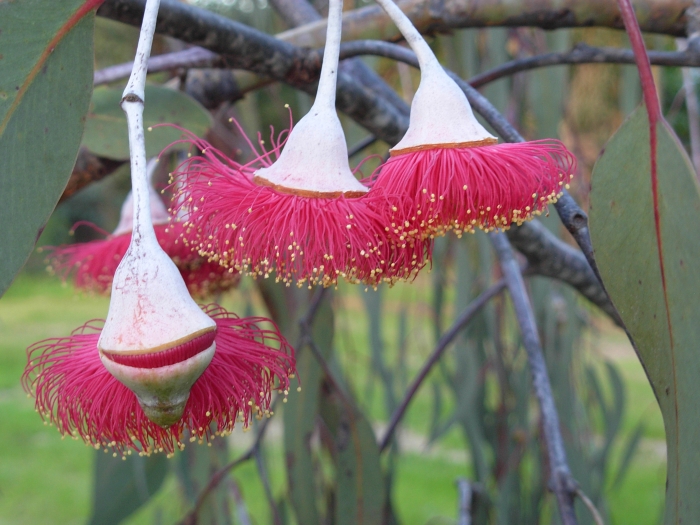Silver Princess
(Eucalyptus caesia)
Silver Princess (Eucalyptus caesia)
/
/

User:JarrahTree
CC BY 2.5 au
Image By:
User:JarrahTree
Recorded By:
Copyright:
CC BY 2.5 au
Copyright Notice:
Photo by: User:JarrahTree | License Type: CC BY 2.5 au | License URL: https://creativecommons.org/licenses/by/2.5/au/deed.en | Uploader: JarrahTree | Publisher: Wikimedia Commons | Title: Caesia_pink_flowers.jpg | Notes: {{Information |Description=Probably Bald Island Marlock (Eucalyptus conferruminata), opercula or flower bud covers and flowers. East Devonport, Devonport, Tasmania, Australia. |Source=self-made - http://arglist.com/cgi-bin/image?gallery=myrtales&na |




























Estimated Native Range
Summary
Eucalyptus caesia, commonly known as Silver Princess or gungurru, is a mallee endemic to the granite outcrops of the Wheatbelt and Goldfields-Esperance regions of Western Australia. It is a small to medium-sized tree, typically growing to 5-15 meters in height and 4-10 meters in width, with a distinctive weeping habit. The bark is smooth and reddish-brown, peeling away in curling flakes to reveal a lighter color underneath. Adult leaves are lance-shaped and may be slightly curved, with a unique waxy, bluish-white bloom that gives the foliage a silvery appearance. The Silver Princess is renowned for its striking display of large, pink flowers with prominent yellow anthers, which bloom mainly between May and September. The flowers are particularly showy, attracting various bird species, and are followed by urn-shaped fruit.
The Silver Princess is highly valued for its ornamental qualities, including its beautiful weeping form, stunning floral display, and attractive bark. It is often used in urban landscaping, as a feature tree in gardens, and for habitat restoration projects. This species is drought-tolerant, making it suitable for xeriscaping. It requires full sun exposure and well-drained soils, preferably sandy or loamy. While it is relatively low-maintenance, it can be susceptible to canker diseases and Phytophthora root rot if conditions are not ideal. The ’Silver Princess’ cultivar is particularly popular for its pronounced weeping habit and prolific flowering.CC BY-SA 4.0
The Silver Princess is highly valued for its ornamental qualities, including its beautiful weeping form, stunning floral display, and attractive bark. It is often used in urban landscaping, as a feature tree in gardens, and for habitat restoration projects. This species is drought-tolerant, making it suitable for xeriscaping. It requires full sun exposure and well-drained soils, preferably sandy or loamy. While it is relatively low-maintenance, it can be susceptible to canker diseases and Phytophthora root rot if conditions are not ideal. The ’Silver Princess’ cultivar is particularly popular for its pronounced weeping habit and prolific flowering.CC BY-SA 4.0
Plant Description
- Plant Type: Tree
- Height: 15-25 feet
- Width: 15-25 feet
- Growth Rate: Rapid
- Flower Color: Purple
- Flowering Season: Winter, Spring
- Leaf Retention: Evergreen
Growth Requirements
- Sun: Full Sun
- Water: Low
- Drainage: Medium, Fast
Common Uses
Bee Garden, Bird Garden, Butterfly Garden, Drought Tolerant, Fragrant, Hummingbird Garden, Low Maintenance, Showy Flowers, Street Planting, Water Garden
Natural Habitat
Granite outcrops of the Wheatbelt and Goldfields-Esperance regions of Western Australia
Other Names
Common Names: Silver Princess, Gungunnu, Caesia
Scientific Names: , Eucalyptus caesia,
GBIF Accepted Name: Eucalyptus caesia Benth.